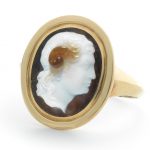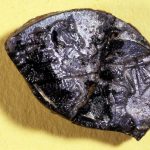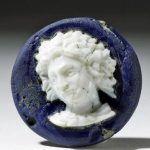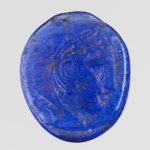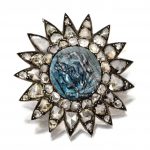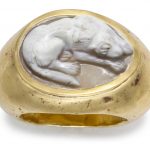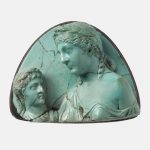Information on Alexander the Great cameos and intaglios. Alexander the Great was the ruler of Macedon 336 BC-323 BC. He conquered the Persian Empire (c.333 BC) and Egypt (332 BC) and extended the borders of his empire as far as India. He was known in Iran and India as Iskandar. Reference: The British Museum
Alexander the Great’s accomplishments and legacy have been depicted in many cultures. Alexander has figured in both high and popular culture beginning in his own era to the present day. The Alexander Romance, in particular, has had a significant impact on portrayals of Alexander in later cultures, from Persian to medieval European to modern Greek.
Alexander features prominently in modern Greek folklore, more so than any other ancient figure. The colloquial form of his name in modern Greek (“O Megalexandros”) is a household name, and he is the only ancient hero to appear in the Karagiozis shadow play. One well-known fable among Greek seamen involves a solitary mermaid who would grasp a ship’s prow during a storm and ask the captain “Is King Alexander alive?” The correct answer is “He is alive and well and rules the world!” causing the mermaid to vanish and the sea to calm. Any other answer would cause the mermaid to turn into a raging Gorgon who would drag the ship to the bottom of the sea, all hands aboard. Reference: Wikipedia
An 18th-19th century sardonyx cameo of Alexander the Great Oval, the beardless profile of Alexander, wearing the ram’s horn of Zeus Ammon, facing right, within a later gold mount, cameo slightly chipped at edge, ring size S, length 12mm, width 8mm
It is said that the cameo portrait began during the reign of Alexander the Great. This cameo, based on the coinage of Lysimachus, King of Thrace (306-281 BC), shows Alexander asserting his divinity by wearing the ram’s horn of Zeus Ammon. It references Alexander’s visit in 331 BC to the oracle of Zeus Ammon in the oasis of Siwa before the invasion of the Persian Empire.
Sold for £ 7,500 inc. premium at Bonhams in 2014
Fragmentary cameo of iridescent blue glass paste, engraved with Alexander the Great on horseback, spearing an enemy who has fallen on his knees, protecting himself with his shield.
© The Trustees of the British Museum
Important Roman Blue & White Glass Cameo
Roman, ca. 1st to 3rd century CE. A breathtaking cameo with a high-relief bust of a young Alexander wearing a Herakles knotted lion skin tied at the neck, in a 3/4 pose, cast and cut from opaque white glass, with a finely delineated visage of naturalistic features, and a mesmerizing curly coiffure, applied to a stunning deep blue glass roundel. So elegant, presenting a poignant portrait of this legendary figure, replete with pristine technique and the utmost artistry. Size: 1.375″ in diameter (3.5 cm)
Sold for $1,695 at Artemis Gallery in 2017
Glass cameo with portrait head of Alexander the Great
Late Republican or Imperial 1st century B.C.–3rd century A.D. Culture: Roman
Portrait head of Alexander the Great wearing a lion skin.
Reference: The Metropolitan Museum of Art
Labradorite Cameo and Diamond Pendant-Brooch, circa 1880 The starburst motif centering a round labradorite cameo carved in classical taste with the profile of a stylized Alexander the Great in the guise of Hercules wearing the skin of the Nemean lion, surrounded by numerous full rose-cut diamonds, mounted in gold and silver.
Sold for 3,750 USD at Sothebys in 2007
